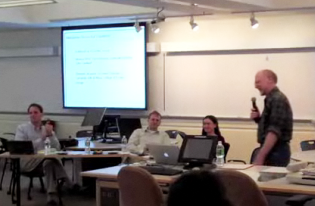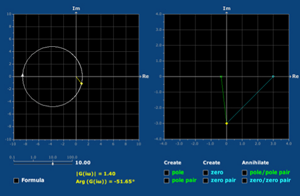Haynes Miller and his colleagues presented to an enthusiastic crowd of over 40 faculty colleagues and educators on Friday, April 23.
 Originally funded in 2000 through a D'Arbeloff grant for course 18.03, Mathlets were designed as tools for "attaching mathematical applications to real world examples" and thus bridging pure math to the applied sciences. Mathlets have grown to a collection of more than 40 individual applets which are constantly modified and updated in response to students and faculty, and which are used in over 6 different course areas at MIT. In additional to providing students with visualization tools for understanding, Mathlets also foster cross-departmental communication through the sharing of teaching materials.
Originally funded in 2000 through a D'Arbeloff grant for course 18.03, Mathlets were designed as tools for "attaching mathematical applications to real world examples" and thus bridging pure math to the applied sciences. Mathlets have grown to a collection of more than 40 individual applets which are constantly modified and updated in response to students and faculty, and which are used in over 6 different course areas at MIT. In additional to providing students with visualization tools for understanding, Mathlets also foster cross-departmental communication through the sharing of teaching materials.
Prof Miller's panel of colleagues included faculty from Physics, Mechanical Engineering and Aeronautics & Astronautics.
Eric Hudson (Physics) talked about using Mathlets to reinforce physics concepts which are difficult for students to understand without visualization support. Using variables for time, phase, current and voltage, Mathlets help students to 'see' relationships that would be difficult to envision from charts and equations. When asked about his students' reactions Hudson said, "It was very positive. For some it was like a light bulb going off."
 Franz Hover (Mechanical engineering) uses the Nyquist Mathlet in his class in the design of electro- mechanical robotics systems. Student success relies on a fundamental understanding of the Nyquist concept. The Nyqust criteria - which students previously had to take on faith - is now revealed in the Mathlets applet. It is "very valuable for giving students the handles they need to understand how changing the parameters.... will affect what the graph looks like" explained Prof Hover.
Franz Hover (Mechanical engineering) uses the Nyquist Mathlet in his class in the design of electro- mechanical robotics systems. Student success relies on a fundamental understanding of the Nyquist concept. The Nyqust criteria - which students previously had to take on faith - is now revealed in the Mathlets applet. It is "very valuable for giving students the handles they need to understand how changing the parameters.... will affect what the graph looks like" explained Prof Hover.
Karen Willcox (Aeronautics & Astronautics) shared how her teaching is more effective using the Mathlets tools because she can show connections between various forces and variables. While some students understand Nyquist concepts through charts and graphs, for many it is overwhelming. The Nyquist applets in the Mathets suite let students see the process through a different perspective. "What used to take two instructors simultaneously charting on the board is now achieved more effectively through the online tool," Prof WIllcox explained. Prof Willcox uses Mathlets both in lecture to illustrate and in recitation for hands-on exercises.
For more information about the Mathlets suite of tools, please visit the mathlets website and the OEIT Mathlets profile.